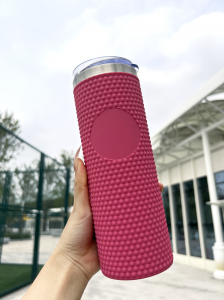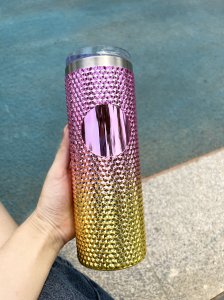Introduction
In today’s society, environmental awareness is increasing, and people are paying more and more attention to the impact of their behavior on the environment. Choosing environmentally friendly products not only helps reduce personal carbon footprints, but also drives the entire society towards sustainable development. Today, we will take a deep look at a seemingly simple but far-reaching choice – using recycled stainless steel water bottles, and analyze the positive impact of this choice on the environment.
1. The production process of stainless steel water bottles and their environmental advantages
The production process of stainless steel water bottles is relatively complicated, but compared with plastic water bottles, its environmental advantages are significant. First, stainless steel is a durable material with a service life far longer than plastic. This means that in the same period of time, the use of stainless steel water bottles can reduce the generation of a large amount of plastic waste. Secondly, although the production of stainless steel requires a certain amount of energy, its recyclability makes this process more environmentally friendly. Recycling stainless steel can significantly reduce the demand for raw materials, reduce energy consumption and greenhouse gas emissions.
1.1 Energy consumption and emissions in the production process
The production process of stainless steel mainly includes ore mining, smelting, rolling and other links. In these processes, a large amount of energy is consumed and certain greenhouse gas emissions are generated. However, compared with plastics, the production process of stainless steel has relatively low energy consumption and emissions per unit product. In addition, modern stainless steel production technology continues to advance, and many companies have adopted more environmentally friendly production processes, further reducing the impact on the environment.
1.2 Recyclability and resource recycling
Stainless steel is a highly recyclable material with a very high recycling rate. According to the International Stainless Steel Forum, the global stainless steel recycling rate has reached more than 80%. This means that most stainless steel products can be recycled and remade into new stainless steel products after their service life, thereby realizing the recycling of resources. This recycling not only reduces the demand for new ore, but also reduces energy consumption and environmental pollution in the production process.
2. Environmental benefits of recycling stainless steel water bottles
Choosing to recycle stainless steel water bottles not only continues the environmental advantages of stainless steel, but also brings more environmental benefits. First, recycling stainless steel water bottles can reduce the demand for new stainless steel, thereby reducing environmental damage during ore mining and smelting. Secondly, recycling stainless steel water bottles can reduce the pressure on landfills and avoid the production of harmful substances by these water bottles decomposing in the natural environment.
2.1 Reduce the environmental impact of ore mining and smelting
Ore mining and smelting are the main environmental impact links in the stainless steel production process. Ore mining destroys surface vegetation, leading to soil erosion and loss of biodiversity. The smelting process produces a large amount of waste gas, wastewater and solid waste, which pollutes the air, water and soil. By recycling stainless steel water bottles, the demand for new ore can be reduced, thereby reducing the damage to the environment in these links.
2.2 Reduce the pressure on landfills
Due to their durability and difficulty in decomposition, stainless steel water bottles will occupy space for a long time if they are discarded in landfills and may pollute soil and groundwater. Recycling stainless steel water bottles can transform them into new useful products, thereby reducing the pressure on landfills and protecting the environment.
3. Environmental impact of recycled stainless steel water bottles during use
During use, recycling stainless steel water bottles also has significant environmental advantages. Compared with disposable plastic water bottles, stainless steel water bottles can be used repeatedly, reducing the generation of plastic waste. In addition, stainless steel water bottles have better thermal insulation performance, which can reduce the demand for disposable insulation materials and further reduce the environmental burden.
3.1 Reduce the generation of plastic waste
Disposable plastic water bottles are one of the main sources of plastic pollution worldwide. According to the United Nations Environment Programme, about 8 million tons of plastic waste enters the ocean every year, posing a serious threat to the marine ecosystem. Recycling stainless steel water bottles can replace the use of a large number of disposable plastic water bottles, thereby reducing the generation of plastic waste and protecting the marine and terrestrial environment.
3.2 Insulation performance and energy conservation
Stainless steel water bottles usually have good insulation performance and can keep the temperature of water for hours or even days. This means that in outdoor activities or daily life, people can reduce their dependence on disposable insulation materials, such as thermos cups and insulation bags. These disposable insulation materials are usually made of non-degradable materials such as polystyrene, which impose a greater burden on the environment. The use of stainless steel water bottles can achieve the insulation function while reducing the demand for these materials and saving energy and resources.
4. Disposal and reuse of recycled stainless steel water bottles
Even after the end of the service life of recycled stainless steel water bottles, their environmental impact is relatively small. Stainless steel water bottles can be recycled and remade into new stainless steel products to achieve the recycling of resources. In addition, some companies have launched product recycling programs to encourage consumers to return discarded stainless steel water bottles to manufacturers to further promote the recycling and reuse of resources.
4.1 Product recycling program and circular economy
Many stainless steel water bottle manufacturers have realized the importance of product recycling and have launched corresponding product recycling programs. For example, some brands will provide consumers with recycling channels to collect discarded stainless steel water bottles for professional treatment and reuse. This practice not only helps to reduce the generation of waste, but also promotes the development of the circular economy and makes resources more efficiently used.
4.2 Innovative reuse methods
In addition to traditional recycling and reuse, there are some innovative ways to extend the service life of stainless steel water bottles. For example, discarded stainless steel water bottles can be transformed into household items such as vases, pen holders, storage jars, or used in gardening, handicrafts and other fields. These innovative reuse methods not only reduce the generation of waste, but also add creativity and fun to people’s lives.
5. Comparison of recycled stainless steel water bottles with other environmentally friendly options
Among environmentally friendly product choices, recycled stainless steel water bottles have unique advantages. Compared with glass water bottles, stainless steel water bottles are lighter, more durable and less likely to break; compared with aluminum water bottles, stainless steel has better thermal insulation performance and does not contain harmful substances such as bisphenol A. In addition, the environmental impact of recycled stainless steel water bottles during the production process is relatively small, making it a more sustainable choice.
5.1 Comparison with water bottles made of other materials
Although glass water bottles have good thermal insulation performance and are non-toxic and odorless, they are heavy and fragile, and are easily damaged during transportation and use, which increases resource waste and environmental burden. Although aluminum water bottles are light, their thermal insulation performance is not as good as stainless steel, and the production process of aluminum requires a lot of energy, which has a greater impact on the environment. In contrast, recycled stainless steel water bottles have comprehensive advantages in weight, durability, thermal insulation performance and environmental impact.
5.2 Sustainable choice under comprehensive consideration
Choosing to recycle stainless steel water bottles is not only an individual environmental protection behavior, but also an attitude of being responsible to society and the environment. After comprehensively considering the environmental impact of various links such as the production process, use process and waste disposal of the product, recycling stainless steel water bottles is undoubtedly a more sustainable choice. It can reduce resource consumption, reduce environmental pollution, and promote the entire society to move towards a circular economy and sustainable development.
Conclusion
Choosing to recycle stainless steel water bottles has many positive effects on the environment. From energy consumption and emissions during the production process, to the reduction of plastic waste and thermal insulation performance during use, to the recycling of resources after disposal, recycled stainless steel water bottles have demonstrated their unique environmental value. In today’s era of growing environmental awareness, each of us should make wise choices and contribute to protecting the earth. Choosing to recycle stainless steel water bottles is not only a respect for the environment, but also a commitment to future generations.
Post time: Mar-21-2025

